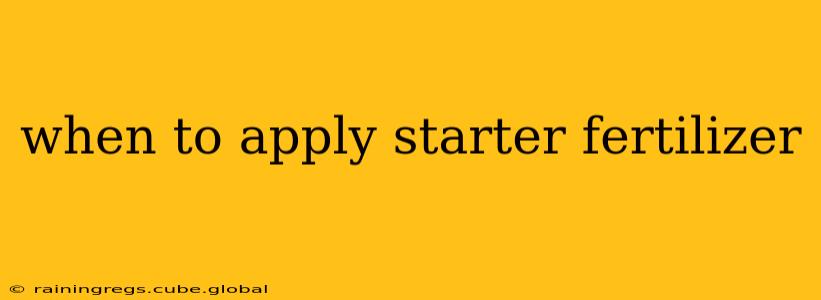Starter fertilizer provides young plants with the essential nutrients they need to establish strong root systems and vigorous early growth. Knowing precisely when to apply it is crucial for maximizing its benefits. This guide will explore the optimal timing, considering various factors and answering common questions.
What is Starter Fertilizer and Why Use It?
Starter fertilizer is a concentrated blend of nutrients, typically high in phosphorus and potassium, applied near the seeds or seedlings at planting. Unlike regular fertilizer, which provides ongoing nutrition, starter fertilizer focuses on giving plants a boost during their critical establishment phase. This initial surge helps them overcome transplant shock, develop robust root systems, and get a head start on growth. Phosphorus is especially vital for root development, while potassium enhances disease resistance.
When is the Best Time to Apply Starter Fertilizer?
The ideal time to apply starter fertilizer is at planting. This ensures the nutrients are immediately available to the young roots as they begin to explore the soil. However, the specific timing within the planting process depends on several factors:
Applying Starter Fertilizer with Seeds:
For seeds, apply the fertilizer at the same time you plant them. This often involves incorporating it directly into the soil before sowing or placing a small amount in the planting hole near the seed. Avoid direct contact between the fertilizer granules and the seed itself, as this can cause burning.
Applying Starter Fertilizer with Seedlings/Transplants:
When transplanting seedlings, apply starter fertilizer at the time of planting, ideally incorporating it into the soil around the root ball. Again, ensure the fertilizer doesn't directly touch the roots. A gentle watering after application helps dissolve the fertilizer and move it into the soil for uptake by the roots.
Considering Soil Conditions:
The type of soil plays a crucial role. If your soil is already rich in nutrients, you may require less starter fertilizer or possibly none at all. Soil testing can help determine your soil's nutrient levels, guiding your fertilization decisions. Sandy soils tend to need more frequent fertilization as nutrients leach out quickly, while clay soils may need less frequent fertilization as nutrients are more retained.
What are the Different Methods of Applying Starter Fertilizer?
Several methods allow for effective starter fertilizer application:
- Banding: Placing fertilizer in bands alongside the seed row or seedling. This keeps fertilizer away from the seed/root while keeping it close enough for uptake. This is commonly used with in-ground planting.
- Incorporating into the soil: Mixing the fertilizer directly into the soil before planting. This is best for smaller gardens and container planting.
- Topdressing: Spreading a thin layer of fertilizer over the soil surface after planting. This is less efficient and might require more frequent applications, but suitable in some contexts.
How Much Starter Fertilizer Should I Use?
The amount of starter fertilizer depends on the plant type, soil conditions, and the fertilizer's analysis (N-P-K ratio). Always follow the instructions on the fertilizer package carefully. Over-application can lead to fertilizer burn, damaging young plants. Under-application might fail to provide sufficient support for early growth.
What if I Miss the Ideal Planting Time for Starter Fertilizer Application?
If you missed applying starter fertilizer at planting, you still might be able to improve your plants' early growth with a light application of a balanced, slow-release fertilizer shortly after. However, the benefits will be less than applying it during planting.
Can I use regular fertilizer instead of starter fertilizer?
While possible, it's not recommended. Regular fertilizers are formulated for ongoing nutrition, often lacking the high phosphorus and potassium concentrations beneficial to early growth. Starter fertilizers provide a targeted boost for establishing young plants.
Does starter fertilizer work with all plants?
Most plants benefit from starter fertilizer, although some may need it more than others. Plants with high nutrient needs during their initial growth phases respond particularly well.
By carefully considering these factors and choosing the appropriate application method, you can leverage starter fertilizer's benefits to maximize your plants' success and yield. Remember to always follow the instructions on the product label and consider conducting a soil test for better informed decisions.
